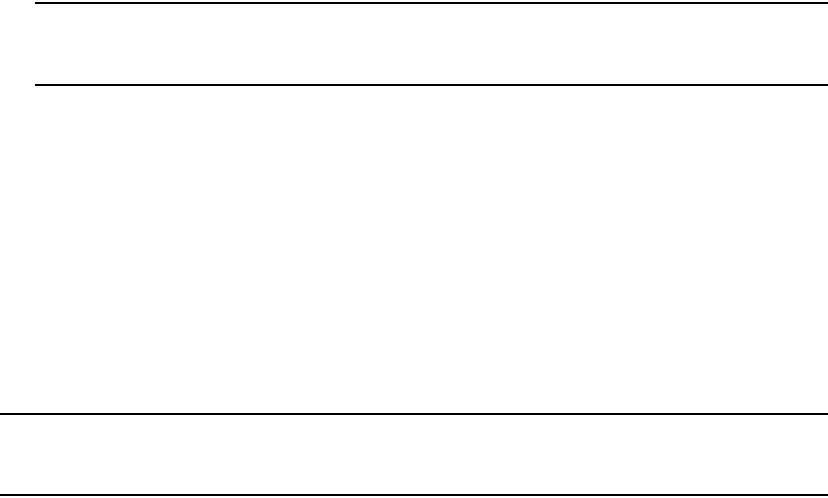Brocade Converged Enhanced Ethernet Administrator's Guide v6.1.2_cee (53-1001258-01, June 2009)
Table Of Contents
- Contents
- Figures
- Tables
- About This Document
- Introducing FCoE
- Using the CEE CLI
- In this chapter
- CEE CLI configuration guidelines and restrictions
- Using the CEE command line interface (CLI)
- CEE CLI RBAC permissions
- Accessing the CEE CLI through the console interface or through a Telnet session
- Accessing the CEE CLI from the Fabric OS shell
- Accessing CEE CLI command modes
- Using CEE CLI keyboard shortcuts
- Displaying CEE CLI commands and command syntax
- Using CEE CLI command completion
- CEE CLI command syntax conventions
- Using CEE CLI command output modifiers
- Configuring VLANs Using the CEE CLI
- In this chapter
- VLAN overview
- Ingress VLAN filtering
- VLAN configuration guidelines and restrictions
- Default VLAN configuration
- VLAN configuration procedures
- Enabling and disabling a CEE interface
- Configuring the MTU on a CEE interface
- Creating a VLAN interface
- Configuring a VLAN interface to forward FCoE traffic
- Configuring a CEE interface as a Layer 2 switch port
- Configuring a CEE interface as an access interface or a trunk interface
- Configuring VLAN classifier rules
- Configuring VLAN classifier groups
- Associating a VLAN classifier group to a CEE interface
- Clearing VLAN counter statistics
- Displaying VLAN information
- Configuring the MAC address table
- Configuring STP, RSTP, and MSTP using the CEE CLI
- In this chapter
- STP overview
- RSTP overview
- MSTP overview
- STP, RSTP, and MSTP configuration guidelines and restrictions
- Default STP, RSTP, and MSTP configuration
- STP, RSTP, and MSTP configuration procedures
- STP, RSTP, and MSTP-specific configuration procedures
- STP and RSTP-specific configuration procedures
- RSTP and MSTP-specific configuration procedures
- MSTP-specific configuration procedures
- 10-Gigabit Ethernet CEE interface-specific configuration
- Global STP, RSTP, and MSTP-related configuration procedures
- Clearing STP, RSTP, and MSTP-related information
- Displaying STP, RSTP, and MSTP-related information
- Configuring Link Aggregation using the CEE CLI
- Configuring LLDP using the CEE CLI
- Configuring ACLs using the CEE CLI
- In this chapter
- ACL overview
- Default ACL configuration
- ACL configuration guidelines and restrictions
- ACL configuration procedures
- Creating a standard MAC ACL and adding rules
- Creating an extended MAC ACL and adding rules
- Modifying a MAC ACL
- Removing a MAC ACL
- Reordering the sequence numbers in a MAC ACL
- Applying a MAC ACL to a CEE interface
- Applying a MAC ACL to a VLAN interface
- Clearing MAC ACL counters
- Displaying MAC ACL information
- Configuring QoS using the CEE CLI
- Configuring FCoE using the Fabric OS CLI
- Administering the switch
- Configuring RMON using the CEE CLI
- Index

Converged Enhanced Ethernet Administrator’s Guide 7
53-1001258-01
Layer 2 Ethernet overview
1
• If the Ethernet frame is too short, the frame is discarded and the error counter is incremented.
• If the Ethernet frame is too long, the frame is discarded and the error counter is incremented.
• Frames sent to a broadcast destination MAC address are flooded on all ports except the
ingress port.
• When MAC address entries in the lookup table time out, they are removed. In this event, frame
forwarding changes from unicast to flood.
• An existing MAC address entry in the lookup table is discarded when a device is moved to a
new location. When a device is moved, the ingress frame from the new port causes the old
lookup table entry to be discarded and the new entry inserted into the lookup table. Frame
forwarding remains unicast to the new port.
• When the lookup table is full, new entries replace the oldest MAC addresses after the oldest
MAC addresses age and timeout. MAC addresses that still have traffic running are not timed
out.
NOTE
New entries start replacing older entries when the lookup table reaches 90 percent of its 32k
capacity.
VLAN tagging
The Brocade 8000 CEE switch handles VLAN tagging as follows:
• If the Brocade 8000 CEE port is configured to tag incoming frames with a single VLAN ID, then
incoming frames that are untagged are tagged with the VLAN ID.
• If the Brocade 8000 CEE port is configured to tag incoming frames with multiple VLAN IDs,
then incoming frames that are untagged are tagged with the correct VLAN ID based on the port
setting.
• If the Brocade 8000 CEE port is configured to accept externally tagged frames, then incoming
frames that are tagged with a VLAN ID are passed through unchanged.
NOTE
To make a VLAN FCoE-capable, you must enable the forwarding of FCoE traffic on the VLAN interface
by entering the fcf forward CEE CLI command on the VLAN interface.
For detailed information on configuring VLANs, see “Configuring VLANs Using the CEE CLI” on
page 25.
Loop-free network environment
The Brocade 8000 CEE switch uses the following protocols to maintain a loop-free network
environment:
• 802.1D Spanning Tree Protocol (STP)—STP is required to create a loop-free topology in the LAN.
• Rapid Spanning Tree Protocol (RSTP)—RSTP evolved from the 802.1D STP standard. RSTP
provides for a faster spanning tree convergence after a topology change.










